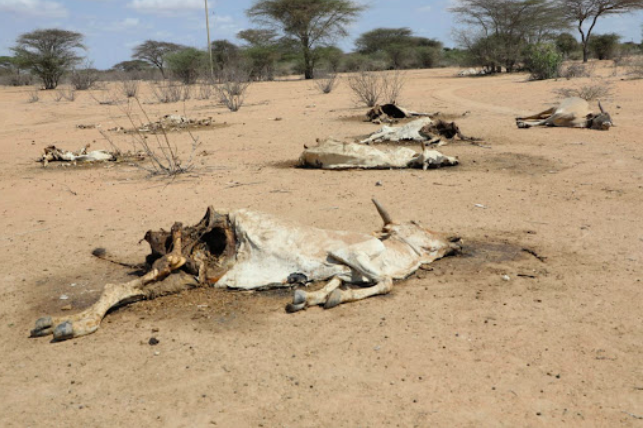
Carcases of livestock/FILE
A new report has shown the water cycle has become increasingly erratic and extreme, swinging between deluge and drought.
The State of Global Water Resources Report by the World Meteorological Organization (WMO) shows only about one-third of the global river basins had “normal” conditions last year.
The rest were either above or below normal – the sixth consecutive year of clear imbalance.
“Water sustains our societies, powers our economies and anchors our ecosystems. And yet the world’s water resources are under growing pressure and – at the same time – more extreme water-related hazards are having an increasing impact on lives and livelihoods,” WMO secretary general Celeste Saulo said.
“Reliable, science-based information is more important than ever before because we cannot manage what we do not measure. The WMO’s State of Global Water Resources Report 2024 is part of WMO’s commitment to provide that knowledge,” she said.
“Continued investment and enhanced collaboration in data sharing are vital to close monitoring gaps. Without data, we risk flying blind,” she said.
The report says last year, deviations of river discharge from normal conditions occurred in approximately 60 per cent of the global catchment area.
“In the past six years only about one third of the global catchment area was under normal discharge conditions when compared to the 1991–2020 average. In 2024, above- to much-above-normal discharge conditions prevailed across Central and Northern Europe and parts of Asia, including Kazakhstan and the Russian Federation,” it says.
In Africa, most large lakes such as Victoria, Turkana, Tanganyika and Chad recorded much-above-normal levels, with the exception of Lake Kariba, which had much-below-normal levels.
Lake surface temperatures were anomalously high globally in July.
The analysis of groundwater levels includes data from 37,406 groundwater monitoring stations across 47 countries.
Groundwater levels vary locally due to aquifer heterogeneity and human influences like pumping; still, larger-scale regional trends were observed.
Last year, 38 per cent of studied stations had normal groundwater levels; 25 per cent were below or much-below-normal and 37 per cent were above or much-above-normal.
The report says l2024 was the third consecutive year in which widespread ice loss was recorded across all glaciated regions, with 450 Gt lost – equivalent to 1.2 mm of sea-level rise.
The annual State of Global Water Resources Report is one of a suite of WMO reports which provides intelligence and insights to decision-makers.
It is an authoritative assessment of global freshwater availability, including stream flow, reservoirs, lakes, groundwater, soil moisture, snow and ice.
It is based on data contributed by WMO members, as well as information from global hydrological modelling systems and satellite observations from a wide range of partners.
The report highlights the critical need for improved monitoring and data sharing.
An estimated 3.6 billion people face inadequate access to water at least a month per year and this is expected to increase to more than five billion by 2050.
According to UN Water, the world is falling far short of Sustainable Development Goal 6 on water and sanitation.
The State of Global Water Resources Report, published annually by WMO, provides a comprehensive quantitative overview of global water resources, with a focus on hydrological variability and trends.
It supports countries, decision makers and partners in understanding the current state of water resources, identifying hotspots and supporting effective water management strategies.
The report is based on data contributed by WMO members, as well as information from global hydrological modelling systems and satellite observations provided by various partners.
The report contains an assessment of global freshwater availability, including streamflow, lakes, groundwater, soil moisture, snow and ice and combined terrestrial water storage.
It also contains map of key hydrological extreme events throughout the year such as floods and droughts and a case study highlighting regional and national water resource conditions.
It also contains comparative analysis of the current state with long-term hydrological normals, and an evaluation of the impact of climate variability and change on water resources and the hydrological cycle.















